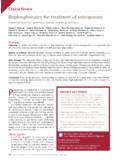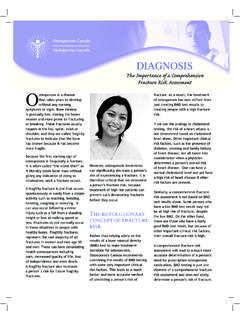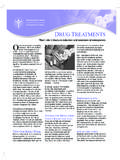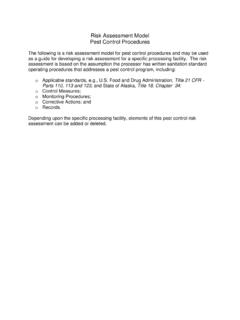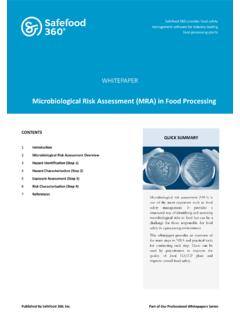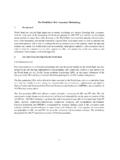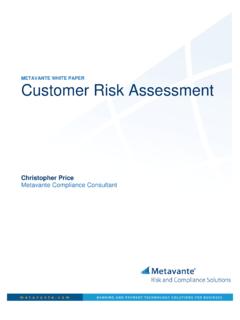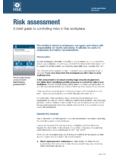Transcription of Osteoporosis For Health Professionals: Fracture Risk ...
1 Module 5 - Speaking of Bones Osteoporosis For Health Professionals: Fracture Risk assessment William D. Leslie, MD MSc FRCPC Case #1 Age 53: 3 years post-menopause Has always enjoyed excellent Health with no past Fracture , medical or surgical history Stable Height = 154 cm ( in.) Stable Weight = kg (122 lbs.) High Caffeine Intake Who Should Be Tested for Osteoporosis ? Brown JP et al. CMAJ 2002. 2002 Guidelines T-scores and Treatment Decisions Age BMD T-scores Action taken 53 Spine: Femoral neck: Ruled out secondary causes Initiated: - risedronate 35 mg weekly - calcium 1500 mg daily - vitamin D 400 IU daily Question Does this healthy 53 year old woman with femoral neck T-score have: (A) normal BMD, (B) osteopenia, (C) Osteoporosis or (D) none of the above?
2 Should a healthy 53 year old woman with femoral neck T-score receive pharmacotherapy to reduce her Fracture risk? Yes or No? Who Should Be Treated for Osteoporosis ? Brown JP et al. CMAJ 2002. Long-term glucocorticoid therapy Start bisphosphonate therapy Obtain DXA BMD for follow-up Personal history of fragility Fracture after age 40 Low DXA BMD (T-score < ) Clinical risk factors (1 major or 2 minor) Non-traumatic vertebral compression deformities AND Low DXA BMD (T-score < ) Consider therapy Repeat DXA BMD after 1or 2 years 2002 Guidelines Who Should Be Treated for Osteoporosis ?
3 Brown JP et al. CMAJ 2002. Long-term glucocorticoid therapy Start bisphosphonate therapy Obtain DXA BMD for follow-up Personal history of fragility Fracture after age 40 Low DXA BMD (T-score < ) Clinical risk factors (1 major or 2 minor) Non-traumatic vertebral compression deformities AND Low DXA BMD (T-score < ) Consider therapy Repeat DXA BMD after 1or 2 years 2002 Guidelines WHO Definition of Osteoporosis A disease characterized by low bone mass and microarchitectural deterioration of bone tissue leading to enhanced bone fragility and a consequent increase in Fracture risk.
4 BMD Categories Age Category Criteria* 50 years Severe (established) Osteoporosis T-score with fragility Fracture Osteoporosis T-score Osteopenia Low bone mass T-score to Normal T-score T-scores: white female reference. X What s Changed? 1980 s 1990 s 2000 s - Clinical risk factors - Absolute Fracture risk - New Fracture risk assessment systems - New integrated management paradigm Key Changes from 20021 to 20102 Increased focus on the clinical impact of fragility fractures Increased focus on the care gap that exists in the identification and treatment of high-risk individuals 1.
5 Brown JP, Josse RG. CMAJ 2002; 167(10 Suppl):S1-34. 2. Papaioannou A, et al. CMAJ 2010. No. of fractures No. of fractures 0 100 200 300 400 500 Most Fragility Fractures in Postmenopausal Women Occur with Low Bone Mass ("Osteopenia") > to to to to to to to Normal Osteo- penia Osteo- porosis WHO category T-score 60 50 40 30 20 10 0 Fracture rate Fracture rate, per 1000 person-years Cranney A, et al. CMAJ 2007; 177(6):575-580. Fragility Fracture : Definition A Fracture occurring spontaneously or following minor trauma such as a fall from standing height or less1,2 Excluding craniofacial, hand, ankle, and foot fractures JA, et al.
6 Osteoporos Int 2001; 12(5):417-427. L, et al. Osteoporos Int 2008; 19:79-86. Consequences of Fracture Increased risk of Hospitalization1 Institutionalization2 Death3-5 Subsequent fracture6-8 Decreased quality of life9- 12 Economic burden on healthcare system2 1. Papaioannou A, et al. Osteoporos Int 2001; 12(10):870-874. 2. Wiktorowicz ME, et al. Osteoporos Int 2001; 12(4):271-278. 3. Ioannidis G, et al. CMAJ 2009; 181(5):265-271. 4. Papaioannou A, et al. J SOGC 2000; 22(8):591-597. 5. Tosteson AN, et al. Osteoporos Int 2007; 18(11):1463-1472.
7 6. Papaioannou A, et al. J SOGC 2000; 22(8):591-597. 7. Colon-Emeric C, et al. Osteoporos Int 2003; 14:879-893. 8. Lindsay R, et al. JAMA 2001; 285:320-323. 9. Sawka AM, et al. Osteoporos Int 2005; 16:1836-1840. 10. Cranney A, et al. J Rheumatol 2005; 32(12):2393-2399. 11. Pasco JA, et al. Osteoporos Int 2005; 16(12):2046-2052. 12. Papaioannou A, et al. Osteoporos Int 2009; 20(5):703-715. Undertreatment of Osteoporosis Post Fracture in women1 diagnosis or treatment forosteoporosisDiagnosis of Osteoporosis onlyPrescribed treatment forosteoporosis1.
8 Bessette L, et al. Osteoporos Int 2008; 19:79-86. 2. Papaioannou A, et al. Osteoporos Int 2008; 19(4):581-587. 3. Giangregorio L, Osteoporos Int 2009; 20(9):1471-8. This care gap is even wider in men and those who reside in long-term care2,3 Post- Fracture Care Gap: Comparison with Heart Attack ~15%~80%020406080100 Anti- Osteoporosis medication postfractureBeta-blockers post heart attack% of patients being treated1 1. Bessette L, et al. Osteoporos Int 2008; 19:79-86. 2. Austin PC, et al. CMAJ 2008; 179(9):901-908. Fracture Risk assessment : Where Are We in 2012?
9 Selected Fracture Systems 2010 Canadianized FRAX / CAROC 10-year Risk assessment : CAROC Semiquantitative method for estimating 10-year absolute risk of a major osteoporotic Fracture * in postmenopausal women and men over age 50 Three zones (low: < 10%, moderate, high: > 20%) Siminoski K, et al. Can Assoc Radiol J 2005; 56(3):178-188. * Fractures of proximal femur, vertebra [clinical], forearm, and proximal humerus 10-year Risk assessment for Women (CAROC Basal Risk) Adapted from Siminoski K, et al. Can Assoc Radiol J 2005; 56(3):178-188.
10 Risk assessment with CAROC: Important Additional Risk Factors Factors that increase CAROC basal risk by one category ( , from low to moderate or moderate to high) Fragility Fracture after age 40 Recent prolonged systemic glucocorticoid use Example of Adjusting Basal Risk: Based on Additional Risk Factors 60-year-old woman Femoral neck T-score = Based on age and T-score alone = moderate risk History of fragility Fracture or prolonged systemic glucocorticoid use would shift her to high risk Adapted from Siminoski K, et al.

